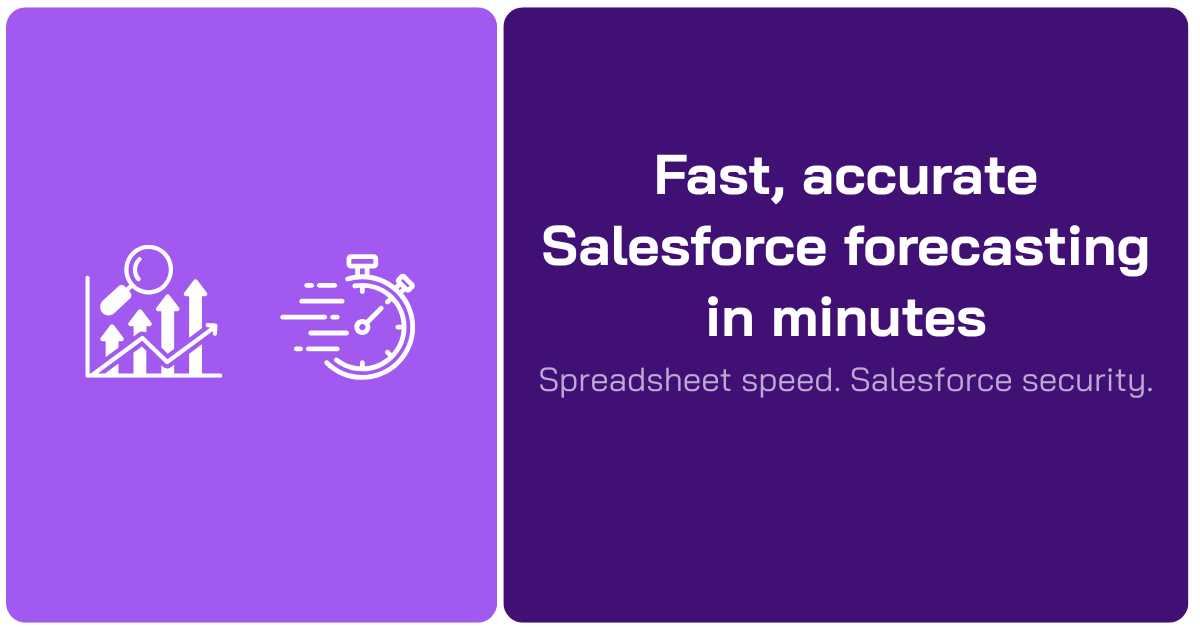Salesforce forecasting at scale: Why growing teams need more than native tools

Imagine this scenario: Your team misses the forecast by 10% in Q1. In Q2, it's 15%, then 20% in Q3. Revenue targets aren’t hit. Investors start asking questions. All because forecasting is slow and siloed.
Salesforce gives you the data and structure. But when your sales org scales—to more products, territories, people, channels—Salesforce forecasting tools can’t keep up. When reps update late, managers don’t have visibility, and approval delays stack up.
The truth is that losing 10‑20% every quarter isn’t about bad luck; it’s a sign that your Salesforce forecasting workflows aren’t serving your growing business.
If you're a RevOps leader or Salesforce admin, ask yourself:
- What’s the true cost of delayed visibility?
- How much does manual reconciliation eat into margin?
- How confident are you in the forecast you present to your leadership?
Why Salesforce forecasting gets more complex as your team scales—and what to do about it
Salesforce is the most powerful and widely adopted CRM tool, but even the best tools need support when operations scale.
As your business grows, forecasting in Salesforce becomes harder.
Only 7% of organizations reach 90%+ forecast accuracy.
Forrester
That’s not just a metric problem—it’s a business problem.
Teams:
- Export data into spreadsheets.
- Manage rollups via email.
- Rely on manual processes to hit tight deadlines.
When speed matters, these cracks can break your revenue engine.
The cost of delays
If three deals a quarter slip due to poor visibility, and each is worth $50,000, that’s $150,000 in lost revenue—per quarter.
If your managers each spend three hours per week reconciling spreadsheets, across 10 managers, that’s 30 hours of non-selling time per week.
Such tiny inefficiencies multiply quickly in fast-moving sales environments.
How to optimize Salesforce forecasting for fast-growing teams?
Let’s look at where Salesforce forecasting typically starts to struggle as companies grow:

These challenges aren’t about Salesforce limitations. They arise because sales operations have outgrown the manual methods they were built on.
See it in action: Watch how Salesforce forecasting grows more complex at scale—and how teams often add workarounds that create new risks.
What should a strong forecasting process look like?
Companies that lead in forecasting maturity follow a few key practices:
- Live pipeline updates: No lag between reality and reporting.
- Role-based collaboration: Everyone can contribute—reps, managers, directors—without extra tools.
- Inline adjustments: Forecast changes happen in context, not in disconnected tools.
- Fast cycle times: Forecast review, approval, and submission take hours, not days.
- Data integrity: Every update passes through rules and validation logic.
This is exactly what Salesforce can do—with the right operational layer.
How Valorx Wave elevates Salesforce forecasting?
Valorx Wave is purpose-built to solve these exact problems—without leaving Salesforce.
Here’s what changes when you use Wave:
🔹 Spreadsheet-speed editing, natively inside Salesforce - Teams can filter, view, and update hundreds of opportunities in seconds without exporting and copy/paste. It’s like working in Excel—but everything stays in Salesforce.
🔹 One-click forecast submissions - Managers can review and submit rollups with a single click. No need to manually reconcile spreadsheets. Submissions sync instantly with dashboards and reports.
🔹 Built-in rules and validations - All updates pass through your existing Salesforce validation logic, approval processes, and field-level controls.
🔹 Zero integration required - Wave is 100% native to Salesforce. It works with your existing metadata, security model, and workflows. Available via AppExchange, it installs and scales easily.
🔹 Admins stay focused on strategy - With no need to build and maintain custom forecasting tools, your Salesforce admins can focus on driving strategy—not troubleshooting workarounds.
Here’s a short walkthrough where we show you how Valorx Wave transforms forecasting into a fast, collaborative process. With Wave, forecasting happens in one grid at spreadsheet speed. Filter, group, and mass-update deals, then watch rollups refresh instantly - live in Salesforce.
Case study: Here’s how a leading steel manufacturer transformed forecasting in Salesforce
A leading U.S. steel manufacturer using Salesforce Manufacturing Cloud struggled with slow, manual forecasting across SKUs, regions, and timeframes, causing reps to fall back to Excel. By implementing Valorx Wave with grid views, they brought spreadsheet-speed forecasting directly into Salesforce, enabling real-time, multi-dimensional updates with full governance. The result was faster forecasting cycles, improved accuracy, and global adoption across teams in just weeks.

Don’t just forecast—execute
Forecasting isn’t just about tracking; it’s about confidence, coordination, and execution.
Salesforce has the foundation. Valorx Wave gives you the operational layer to scale it.
If your current forecasting process feels slow, error-prone, or too manual, there’s a better way to do it inside Salesforce.
Book a demo to see how Wave can help you modernize forecasting, reduce admin effort, and improve forecast accuracy—without leaving Salesforce.

Tags:
ForecastingWeb-based CRM-Connectivity
Get started with Wave
Create a Valorx account and enjoy using Wave for free.
